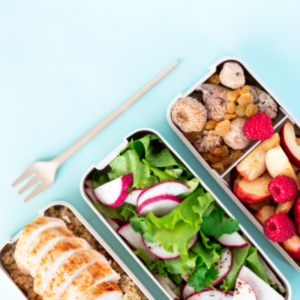
Toddlers grow at a slower rate than infants. Although normal growth differs from child to child, they grow on average 2.5 inches and gain 4-5 pounds each year. Because of this slowed growth, they might experience a reduction in their appetite and could suddenly refuse certain favorite foods. This is known as a food jag. Although common with toddlers, it can make mealtimes stressful for parents and caregivers. Additionally, toddlers can become easily distracted during mealtimes.
During this challenging time, it is important for parents to supply the Three W’s at meals and snacks to ensure proper nutrition and to establish patterns of healthy eating and active living that lead to lifelong health and wellness. This “Division of Responsibility” is that parents, grandparents and adult caregivers are ultimately responsible for what foods are offered, and when and where they’re eaten. Young children decide whether to eat the foods offered and how much.
Tips for Caregivers to supply food the right way
 1) Have scheduled meals and snack times at the table, free of distractions (such as TV, ipads, phones, toys). Generally, three meals and 2-3 snacks between meals will give your toddler an opportunity to meet his/her nutritional needs for the day. Snacks should be offered two or more hours before meals so youngsters come to the table hungry.
1) Have scheduled meals and snack times at the table, free of distractions (such as TV, ipads, phones, toys). Generally, three meals and 2-3 snacks between meals will give your toddler an opportunity to meet his/her nutritional needs for the day. Snacks should be offered two or more hours before meals so youngsters come to the table hungry.
2.) Avoid allowing toddlers access to help him/herself to foods and liquids (other than water) between established meals and snacks. Grazing throughout the day can greatly affect their appetite at established meal/snack times.
3.) Offer a variety of foods with different textures, tastes and colors. Allow your toddler to help pick out new foods at the grocery store and prepare them at home! Offer new foods with preferred foods to make the meal less intimidating.
4.) Do not make mealtimes a fight by force-feeding, bribery or punishment. Allow your toddler to feed him/herself! Generally, a toddler’s attention span at meals is not more than 15-20 minutes.
5.) Playing with food is usually a sign your child is finished eating. Play is an important part of the sensory experience of food during this phase and is normal – expect a mess!
Recommendations from American Heart Association and Academy of Pediatrics
 The American Heart Association and American Academy of Pediatrics recommends beginning a low-fat milk or dairy alternative at the age of 2 years, unless poor weight gain is of concern. Do not give more than 24 ounces of skim or 1% milk per day because excessive milk can replace your toddler’s appetite for whole foods. Do not give more than 4 ounces, or a half-cup of 100% juice per day. Sweetened beverages such as Kool Aid, lemonade and sodas should be avoided because they contain excessive amounts of sugar for your growing child and are a source of empty calories with little to no nutrition. Avoid fried foods and fast foods as much as possible.
The American Heart Association and American Academy of Pediatrics recommends beginning a low-fat milk or dairy alternative at the age of 2 years, unless poor weight gain is of concern. Do not give more than 24 ounces of skim or 1% milk per day because excessive milk can replace your toddler’s appetite for whole foods. Do not give more than 4 ounces, or a half-cup of 100% juice per day. Sweetened beverages such as Kool Aid, lemonade and sodas should be avoided because they contain excessive amounts of sugar for your growing child and are a source of empty calories with little to no nutrition. Avoid fried foods and fast foods as much as possible.
Follow the Healthy Kids Plate to incorporate all the food groups (see image). Most importantly, toddlers are not young adults and should be served toddler-size portions from each food group (about the size of their fist).
If you have concerns about how much your toddler eats, picky eating or problem feeding, and how your toddler is growing, talk with a pediatric registered dietitian at Nutrition Healthworks Gina Gilchrist Nutritionist | Registered Dietitian: Nutrition HealthWorks
Feeding guides, including recommended serving sizes for the various food groups in each stage of development, can be provided during your nutrition visits to help direct you along your journey.
